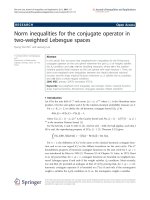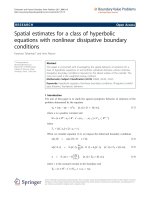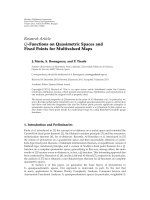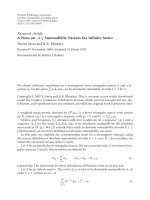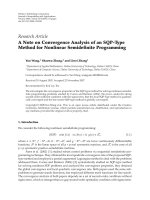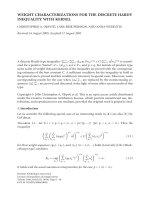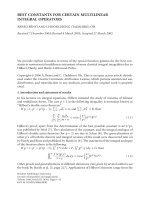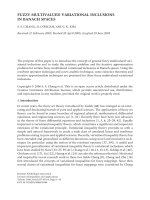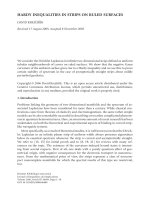Báo cáo hóa học: "WEIGHTED ESTIMATES FOR COMMUTATORS ON NONHOMOGENEOUS SPACES" pot
Bạn đang xem bản rút gọn của tài liệu. Xem và tải ngay bản đầy đủ của tài liệu tại đây (537.78 KB, 14 trang )
WEIGHTED ESTIMATES FOR COMMUTATORS
ON NONHOMOGENEOUS SPACES
WENGU CHEN AND BING ZHAO
Received 14 November 2005; Revised 8 March 2006; Accepted 11 March 2006
Let μ be a Borel measure on
R
d
which may be nondoubling. The only condition that μ
must satisfy is μ(Q)
≤ c
0
l(Q)
n
for any cube Q ⊂ R
d
with sides parallel to the coordinate
axes and for some fixed n with 0 <n
≤ d. This paper is to establish the weighted norm
inequality for commutators of Calder
´
on-Zygmund operators with RBMO( μ) functions
by an estimate for a variant of the sharp maximal function in the context of the nonho-
mogeneous spaces.
Copyright © 2006 W. Chen and B. Zhao. This is an open access article distributed under
the Creative Commons Attribution License, which permits unrestricted use, distribution,
and reproduction in any medium, provided the original work is properly cited.
1. Introduction
Let μ be some nonnegative Borel measure on
R
d
satisfying
μ(Q)
≤ c
0
l(Q)
n
(1.1)
for any cube Q
⊂ R
d
with sides parallel to the coordinate axes, where l(Q) stands for
the side length of Q and n is a fixed real number such that 0 <n
≤ d. Throughout this
paper, all cubes we will consider will be those with sides parallel to the coordinate axes.
For r>0, rQ will denote the cube with the same center as Q and with l(rQ)
= rl(Q).
Moreover , Q(x, r) will be the cube centered at x with side length r.
The classical theory of harmonic analysis for maximal functions and singular inte-
grals on (
R
d
,μ) has been developed under the assumption that the underlying mea-
sure μ satisfies the doubling property, that is, there exists a constant c>0suchthat
μ(B(x,2r))
≤ cμ(B(x,r)) for every x ∈ R
d
and r>0. But recently, many classical results
have been proved still valid without the doubling condition; see [1–18] and their refer-
ences.
Orobitg and P
´
erez [11] have studied an analogue of the classical theory of A
p
(μ)
weights in
R
d
without assuming that the underlying measure μ is doubling. Then, they
Hindawi Publishing Corporation
Journal of Inequalities and Applications
Volume 2006, Article ID 89396, Pages 1–14
DOI 10.1155/JIA/2006/89396
2 Commutator on nonhomogeneous space
obtained weighted norm inequalities for the (centered) Hardy-Littlewood maximal func-
tion and corresponding weighted estimates for nonclassical Calder
´
on-Zygmund oper-
ators. They also considered commutators of those Calder
´
on-Zygmund operators with
BMO(μ) functions. The purpose of this paper is to establish weighted estimates for com-
mutators of those nonclassical Calder
´
on-Zygmund operators with RBMO(μ) in this new
setting.
Let us introduce some notations and definitions. Given two cubes Q
⊂ R in R
d
,weset
K
Q,R
= 1+
N
Q,R
k=1
μ
2
k
Q
l
2
k
Q
n
, (1.2)
where N
Q,R
is the first integer k such that l(2
k
Q) ≥ l(R). K
Q,R
was introduced by Tolsa in
[15].
Given β
d
(depending on d) big enough (e.g., β
d
> 2
n
), we say that some cube Q ⊂ R
d
is doubling if μ(2Q) ≤ β
d
μ(Q).
Given a cube Q
⊂ R
d
,letN be the smallest integer ≥ 0suchthat2
N
Q is doubling. We
denote this cube by
Q.
Let η>1 b e some fixed constant. We say that a function b(x)isinRBMO(μ)ifthere
exists some constant c
1
such that for any cube Q,
1
μ(ηQ)
Q
b − m
Q
b
dμ ≤ c
1
,
m
Q
b − m
R
b
≤
c
1
K
Q,R
for any two doubling cubes Q ⊂ R,
(1.3)
where m
Q
b = 1/μ(Q)
Q
bdμ. The minimal constant c
1
is the RBMO(μ)normofb,andit
will be denoted by
b
∗
. The RBMO(μ) function space was introduced by Tolsa in [15]
and shares more properties with the classical BMO function space than BMO(μ)space.
We say a kernel k(x, y):
R
d
× R
d
\{(x, y):x = y}→C is an n-dimensional Calder
´
on-
Zygmund kernel in the new setting if
(1)
|k(x, y)|≤A/|x − y|
n
if x = y,
(2) there exists 0 <γ
≤ 1suchthat
k(x, y) − k(x
, y)
+
k(y,x) − k(y,x
)
≤
A|x − x
|
γ
|x − y|
n+γ
(1.4)
if
|x − y| > 2|x − x
|.
A bounded linear operator T from L
2
(μ)toL
2
(μ)issaidtobeaCalder
´
on-Zygmund
operator with n-dimensional kernel k if for every compacted supported function f
∈
L
2
(μ),
Tf(x)
=
R
d
k(x, y) f (y)dμ(y)forx ∈ supp f. (1.5)
For r>0, we define the truncated operators by
T
r
f (x) =
R
d
\B(x,r)
k(x, y) f (y)dμ(y) (1.6)
W. Chen and B. Zhao 3
and define the maximal operator associated with T as follows:
T
∗
f (x) = sup
r>0
T
r
f (x)
. (1.7)
2. Sharp maximal function estimates for commutators
In [15], Tolsa defined a sharp maximal operator M
#
f (x)suchthat
f
∈ RBMO(μ) ⇐⇒ M
#
f ∈ L
∞
(μ), (2.1)
where
M
#
f (x) = sup
x∈Q
1
μ
(3/2)Q
Q
f − m
Q
f
dμ+sup
x∈Q⊂R
Q,R doubling
m
Q
f − m
R
f
K
Q,R
. (2.2)
We also consider the noncentered doubling maximal operator N:
Nf(x) = sup
x∈Q
Q doubling
1
μ(Q)
Q
| f |dμ. (2.3)
By [15,Remark2.3],forμ-almost all x
∈ R
d
one can find a sequence of doubling cubes
{Q
k
}
k
centered at x with l(Q
k
) → 0ask →∞such that
lim
k→∞
1
μ
Q
k
Q
k
b(y)dμ(y) = b(x). (2.4)
So,
| f (x)|≤Nf(x)forμ-a.e. x ∈ R
d
. Moreover, it is easy to show that N is of weak type
(1,1) and bounded on L
p
(μ), p ∈ (1,∞].
In order to obtain the estimate for a variant of the sharp maximal function for the
commutators of Calder
´
on-Zygmund operators defined as above with RBMO(μ) func-
tions, we need the following definition.
A function B :[0,
∞) → [0,∞) is called a Young function if it is continuous, convex,
increasing, and satisfying B(0)
= 0andB(t) →∞as t →∞. We define the B-average of a
function f over a cube Q by means of the following Luxemburg norm:
f
B,Q,(ρ)
= inf
λ>0:
1
μ(ρQ)
Q
B
f (y)
λ
dμ ≤ 1
. (2.5)
The generalized H
¨
older’s inequality
1
μ(ρQ)
Q
f (y)g(y)
dμ(y) ≤f
B,Q,(ρ)
g
B,Q,(ρ)
(2.6)
holds, where
B is the complementary Young function associated to B.Foreverylocally
integrable function f , define its maximal operator M
B,(ρ)
by
M
B,(ρ)
f (x) = sup
x∈Q
f
B,Q,(ρ)
. (2.7)
4 Commutator on nonhomogeneous space
Theorem 2.1. Let b
∈ RBMO(μ),let0 <δ< < 1,thereexistsC = C
δ,
such that
M
#
δ
[b,T] f
(x) ≤ Cb
∗
M
,(3/2)
(Tf)(x)+M
2
(9/8)
f (x)+T
∗
f (x)
, (2.8)
where M
#
δ
f (x) = M
#
(| f |
δ
)
1/δ
, M
p,(ρ)
f (x) = sup
x∈Q
((1/μ(ρQ))
Q
| f |
p
dμ)
1/p
, 0 <p<∞.
Set M
(ρ)
f (x) = M
1,(ρ)
f (x).
Before proving the theorem, another equivalent norm for RBMO(μ) is needed. Sup-
pose that for a given function b
∈ L
1
loc
(μ) there exist some c
2
and a collection of numbers
{b
Q
}
Q
(i.e., for each cube Q, there exists b
Q
∈ R)suchthat
sup
Q
1
μ(ηQ)
Q
b − b
Q
dμ ≤ c
2
,
b
Q
− b
R
≤
c
2
K
Q,R
for any two cubes Q ⊂ R.
(2.9)
Then, set
b
∗∗
= inf c
2
, where the infimum is taken over all the constants c
2
and all the
numbers
{b
Q
} satisfying (2.9). By [15, Lemma 2.8, page 99], for a fixed η>1, the norms
·
∗
and ·
∗∗
are equivalent.
Proof of Theorem 2.1. We follow the argument from [15, proof of Theorem 9.1]. Let Q
=
Q(x,r) be a cube with center x and side length r.For0<δ<1andα,β ∈ R,wehave
||α|
δ
−|β|
δ
|≤|α − β|
δ
.Let{b
Q
}
Q
be a sequence of numbers satisfying
Q
b − b
Q
dμ ≤ 2μ(2Q)b
∗∗
, (2.10)
for all cubes Q and
b
Q
− b
R
≤
2K
Q,R
b
∗∗
(2.11)
for all cubes Q, R with Q
⊂ R. For any cube Q, we denote h
Q
:=−m
Q
(T((b − b
Q
) fχ
R
d
\
(4/3)Q)). We will show that for all x, Q with x ∈ Q,
1
μ
(3/2)Q
Q
[b,T] f − h
Q
δ
dμ
1/δ
≤ Cb
∗∗
M
,(3/2)
(Tf)(x)+M
2
(9/8)
f (x)
;
(2.12)
and for all cubes Q, R with Q
⊂ R, x ∈ Q,
h
Q
− h
R
≤
Cb
∗∗
M
2
(9/8)
f (x)+T
∗
f (x)
K
2
Q,R
. (2.13)
To obtain (2.12)forsomefixedcubeQ and x with x
∈ Q,werewrite[b,T] f :
[b,T] f
=
b − b
Q
Tf− T
b − b
Q
f
1
−
T
b − b
Q
f
2
, (2.14)
W. Chen and B. Zhao 5
where f
1
= fχ
(4/3)Q
, f
2
= f − f
1
. Let us estimate the term (b − b
Q
)Tf first. Take 1 <r<
ε/δ.ByH
¨
older’s inequality, we have
1
μ
(3/2)Q
Q
b(y) − b
Q
Tf(y)
δ
dμ(y)
1/δ
≤
1
μ
(3/2)Q
Q
b(y) − b
Q
δr
dμ(y)
1/δr
1
μ
(3/2)Q
Q
Tf(y)
δr
dμ(y)
1/δr
≤ Cb
∗∗
M
δr,(3/2)
(Tf)(x) ≤ Cb
∗∗
M
ε,(3/2)
(Tf)(x).
(2.15)
Since T : L
1
(μ) → L
1,∞
(μ) (see [9]) and 0 <δ<1, Kolmogorov’s inequality and gener-
alized H
¨
older’s inequality yield
1
μ
(3/2)Q
Q
T
b − b
Q
f
1
(y)
δ
dμ(y)
1/δ
≤
1
μ
(3/2)Q
(4/3)Q
b(y) − b
Q
f (y)
dμ(y)
≤ C
b − b
Q
expL,(4/3)Q,(9/8)
f
LLog L,(4/3)Q,(9/8)
,
(2.16)
while John-Nirenberg inequality implies that
1
μ
(3/2)Q
(4/3)Q
exp
b(y) − b
Q
Cb
∗
dμ(y) ≤ C
0
. (2.17)
So there exists a positive constant C such that for all cubes Q,
b − b
Q
expL,(4/3)Q,(ρ)
≤ Cb
∗
. (2.18)
Therefore
1
μ((3/2)Q)
Q
T
b − b
Q
f
1
(y)
δ
dμ(y)
1/δ
≤ Cb
∗
M
LLog L,(9/8)
f (x).
(2.19)
In order to p rove (2.12), we only need to estimate
|T((b − b
Q
) f
2
) − h
Q
|
δ
.Notethat
K
Q,2
k
(4/3)Q
= 1+
k+1
j=1
μ
2
j
Q
l
2
j
Q
n
≤ 1+(k +1)C
0
≤ Ck. (2.20)
6 Commutator on nonhomogeneous space
For x, y
∈ Q,wehave
T
b − b
Q
f
2
(x) −
T
b − b
Q
f
2
(y)
≤
C
R
d
\(4/3)Q
|y − x|
γ
|z − x|
n+γ
b(z) − b
Q
f (z)
dμ(z)
≤ C
∞
k=1
2
k
(4/3)Q\2
k−1
(4/3)Q
l(Q)
γ
|z−x|
n+γ
b(z)−b
2
k
(4/3)Q
+
b
Q
− b
2
k
(4/3)Q
f (z)
dμ(z)
≤ C
∞
k=1
2
−kγ
1
l
2
k
Q
n
2
k
(4/3)Q
b(z) − b
2
k
(4/3)Q
f (z)
dμ(z)
+ C
∞
k=1
k2
−kγ
b
∗
1
l
2
k
Q
n
2
k
(4/3)Q
f (z)
dμ(z)
≤ C
∞
k=1
2
−kγ
1
μ
(9/8)2
k
(4/3)Q
2
k
(4/3)Q
b(z) − b
2
k
(4/3)Q
f (z)
dμ(z)
+ C
∞
k=1
k2
−kγ
b
∗
M
(9/8)
f (x)
≤ C
∞
k=1
2
−kγ
b − b
2
k
(4/3)Q
expL,2
k
(4/3)Q,(9/8)
f
LLog L,2
k
(4/3)Q,(9/8)
+ Cb
∗
M
(9/8)
f (x)
≤ Cb
∗
M
LLog L,(9/8)
f (x)+Cb
∗
M
(9/8)
f (x).
(2.21)
For ρ>1, it is easy to see M
(ρ)
f (x) ≤ M
LLog L,(ρ)
f (x). Thus
T
b − b
Q
f
2
(x) −
T
b − b
Q
f
2
(y)
≤
Cb
∗
M
LLog L,(9/8)
f (x). (2.22)
According to Jensen’s inequality, we obtain
1
μ
(3/2)Q
Q
T
b − b
Q
f
2
(y) − m
Q
T
b − b
Q
f
2
δ
dμ(y)
1/δ
≤
1
μ
(3/2)Q
Q
T
b − b
Q
f
2
(y) − m
Q
T
b − b
Q
f
2
dμ(y)
≤ Cb
∗
M
LLog L,(9/8)
f (x).
(2.23)
Note that for ρ>1, M
2
(ρ)
f (x) ≈ M
LLog L,(ρ)
f (x). By (2.15), (2.16), and (2.23)weobtain
(2.12).
W. Chen and B. Zhao 7
For
{h
Q
}
Q
,wewanttoprove(2.13). Consider two cubes Q ⊂ R and x ∈ Q. We denote
N
= N
Q,R
+1.Wewriteh
Q
− h
R
in the following way:
m
Q
T
b − b
Q
fχ
R
d
\(4/3)Q
−
m
R
T
b − b
R
fχ
R
d
\(4/3)R
≤
m
Q
T
b − b
Q
fχ
2Q\(4/3)Q
+
m
Q
T
b
Q
− b
R
fχ
R
d
\2Q
+
m
Q
T
b − b
R
fχ
2
N
Q\2Q
+
m
Q
T
b − b
R
fχ
R
d
\2
N
Q
−
m
R
T
b − b
R
fχ
R
d
\2
N
Q
+
m
R
T
b − b
R
fχ
2
N
Q\(4/3)R
=
M
1
+ M
2
+ M
3
+ M
4
+ M
5
.
(2.24)
Let us estimate M
1
.Fory ∈ Q we have
T
b − b
Q
fχ
2Q\(4/3)Q
(y)
≤
C
l(2Q)
n
2Q
b − b
Q
|
f |dμ
≤ C
b − b
Q
expL,2Q,(9/8)
f
LLog L,2Q,(9/8)
≤ Cb
∗
M
LLog L,(9/8)
f (x) ≤ Cb
∗
M
2
(9/8)
f (x).
(2.25)
So we derive M
1
≤ Cb
∗
M
2
9/8)
f (x). Let us consider M
2
.Forx, y ∈ Q,
Tf
χ
R
d
\2Q
(y)
=
R
d
\2Q
f (z)k(y, z)dμ(z)
≤
R
d
\2Q
f (z)
k(y,z) − k(x,z)
dμ(z)
+
R
d
\2Q
k(x,z) f ( z)dμ(z)
≤
R
d
\2Q
|y − z|
γ
|y − z|
n+γ
f (z)
dμ(z)
+ T
∗
f (x)
≤ C sup
Q
0
x
1
l
Q
0
n
Q
0
| f |dμ + T
∗
f (x) ≤ CM
(9/8)
f (x)+T
∗
f (x).
(2.26)
Thus
M
2
=
b
R
− b
Q
Tf
χ
R
d
\2Q
≤
CK
Q,R
b
∗
T
∗
f (x)+CM
2
(9/8)
f (x)
. (2.27)
For the t erm M
4
, we execute the process as in (2.21). For any y,z ∈ R
d
,weget
T
b − b
R
fχ
R
d
\2Q
(y) − T
b − b
R
fχ
R
d
\2Q
(z)
≤
Cb
∗
M
LLog L,(9/8)
f (x) ≤ Cb
∗
M
2
(9/8)
f (x).
(2.28)
8 Commutator on nonhomogeneous space
The term M
5
can be estimated as M
1
.Wecanobtain
M
5
≤ Cb
∗
M
2
(9/8)
f (x). (2.29)
FinallywehavetodealwithM
3
.Fory ∈ Q,wehave
b
2
k+1
Q
− b
R
≤
CK
2
k+1
Q,R
b
∗
≤ CK
Q,R
b
∗
. (2.30)
Then,
T
b − b
R
fχ
2
N
\2Q
(y)
≤
C
N−1
k=1
1
l
2
k
Q
n
2
k+1
Q\2
k
Q
b − b
R
|
f |dμ
≤ C
N−1
k=1
1
l
2
k
Q
n
2
k+1
Q
b − b
2
k+1
Q
|
f |dμ + C
N−1
k=1
×
1
l
2
k
Q
n
2
k+1
Q
b
2
k+1
Q
− b
R
|
f |dμ
≤ C
N−1
k=1
b − b
2
k+1
Q
expL,2
k+1
Q,(9/8)
f
LLog L,2
k+1
Q,(9/8)
+ C
N−1
k=1
K
Q,R
b
∗
μ
2
k+1
Q
l
2
k
Q
n
1
μ
2
k+1
Q
2
k+1
Q
| f |dμ
≤ Cb
∗
M
LLog L,(9/8)
f (x)+CK
Q,R
b
∗
N−1
k=1
μ
2
k+1
Q
l
2
k
Q
n
M
(9/8)
f (x)
≤ Cb
∗
M
LLog L,(9/8)
f (x)+CK
2
Q,R
b
∗
M
(9/8)
f (x)
≤ Cb
∗
M
2
(9/8)
f (x)K
2
Q,R
.
(2.31)
Taking the mean over Q,weget
M
3
≤ Cb
∗
M
2
(9/8)
f (x)K
2
Q,R
. (2.32)
By the estimates on M
1
, M
2
, M
3
, M
4
, M
5
,wecanget(2.13).
Let us see how from (2.12)and(2.13) one obtains (2.8). If Q is a doubling cube and
x
∈ Q,thenwehaveby(2.12)
m
Q
[b,T] f
δ
−
h
δ
Q
1/δ
≤
1
μ(Q)
Q
[b,T] f
δ
− h
δ
Q
dμ
1/δ
≤ Cb
∗
M
,(3/2)
(Tf)(x)+M
2
(9/8)
f (x)+T
∗
f (x)
.
(2.33)
W. Chen and B. Zhao 9
Also, for any cube Q
x, K
Q,
Q
≤ C, and then by (2.12)and(2.13)weget
1
μ((3/2)Q)
Q
[b,T] f
δ
− m
Q
[b,T] f
δ
dμ
1/δ
≤
1
μ
(3/2)Q
Q
[b,T] f
δ
−
h
Q
δ
dμ
1/δ
+
h
Q
δ
−
h
Q
δ
1/δ
+
h
Q
δ
− m
Q
[b,T] f
δ
1/δ
≤
1
μ
(3/2)Q
Q
[b,T] f − h
Q
δ
dμ
1/δ
+
h
Q
− h
Q
+
h
δ
Q
− m
Q
[b,T] f
δ
1/δ
≤ Cb
∗
M
,(3/2)
(Tf)(x)+M
2
(9/8)
f (x)+T
∗
f (x)
.
(2.34)
On the other hand, for all doubling cubes Q
⊂ R with x ∈ Q such that K
Q,R
≤ P
0
,where
P
0
is the constant in [15, Lemma 9.3, page 143]. By (2.13)wehave
h
Q
− h
R
≤
Cb
∗
M
2
(9/8)
f (x)+T
∗
f (x)
K
Q,R
P
0
. (2.35)
So by [15, Lemma 9.3, page 143], we get
h
Q
− h
R
≤
Cb
∗
M
2
(9/8)
f (x)+T
∗
f (x)
K
Q,R
(2.36)
for all doubling cubes Q
⊂ R with x ∈ Q, using (2.13)again,weget
m
Q
[b,T] f
δ
−
m
R
[b,T] f
δ
≤
m
Q
[b,T] f
δ
−
h
δ
Q
+
h
δ
Q
− h
δ
R
+
h
δ
R
− m
R
[b,T] f
δ
≤
C
b
∗
M
,(3/2)
(Tf)(x)+M
2
(9/8)
f (x)+T
∗
f (x)
K
Q,R
δ
.
(2.37)
From the above estimates, we can obtain
M
#
δ
[b,T] f
(x) ≤ Cb
∗
M
,(3/2)
(Tf)(x)+M
2
(9/8)
f (x)+T
∗
f (x)
. (2.38)
Now we are in the position to give the definition of weights we will consider. Here we
will consider the A
p
(μ) weights introduced by Orobitg and P
´
erez in [11]. So we need the
assumption that μ(∂Q)
= 0 for any cube Q with sides parallel to the coordinates axes.
Let 1 <p<
∞ and let p
= p/(p − 1). We say that a weight w satisfies the A
p
(μ)condi-
tion if there exists a constant K such that for all cubes Q
1
μ(Q)
Q
wdμ
1
μ(Q)
Q
w
1−p
dμ
p−1
≤ K. (2.39)
And we define the A
∞
(μ)classasA
∞
(μ) =
p>1
A
p
(μ).
10 Commutator on nonhomogeneous space
Theorem 2.2. Let 0 <p<
∞,letρ>1, w(x) ∈ A
∞
(μ) defined above, then
R
d
Tf(x)
p
w(x)dμ(x) ≤ C
R
d
M
(ρ)
f (x)
p
w(x)dμ(x) (2.40)
holds for every function f for which the left-hand side is finite.
Proof. For each
> 0 we define the maximal operator
T
∗
f (x) = sup
δ>
T
δ
f (x)
. (2.41)
We only need to prove that for w
∈ A
∞
(μ), there exist suitable constants α, β, ε such that
w
x : T
∗
f (x) > (1 + β)t, M
(ρ)
f (x) ≤ εt
≤
αw
x : T
∗
f (x) >t
, t>0, (2.42)
for all α
p
< (1 + β)
−1
.Wemayassume f is nonnegative and locally integrable. Follow the
idea of [11], we first consider the special case when w
= 1, then (2.42)turnsto
μ
x : T
∗
f (x) > (1 + β)t, M
(ρ)
f (x) ≤ εt
≤
αμ
x : T
∗
f (x) >t
. (2.43)
Since Ω
={x ∈ R
d
: T
∗
f (x) >t} is open, we decompose it into disjoint Whitney cubes
Ω
=
j
Q
j
,whereQ
j
are disjoint and 2ρdiam(Q
j
) ≤ dist(Q
j
,Ω
c
) ≤ 8ρdiam(Q
j
), and ev-
ery point of
R
d
at most lies in 4ρQ
j
cubes. Obviously 4ρQ
j
⊂ Ω. We will show that for
given β>0, 0 <α<1, there exists c
= c(β,α,n) such that for all j,
μ
x ∈ Q
j
: T
∗
f (x) > (1 + β)t, M
(ρ)
f (x) ≤ εt
≤
αμ
4Q
j
. (2.44)
Summing over all j,wehave
μ
x ∈ R
d
: T
∗
f (x) > (1 + β)t, M
(ρ)
f (x) ≤ εt
≤
α4
n
μ(Ω). (2.45)
Choose α such that α4
n
< 1, then we can obtain (2.42) in the special case. For the general
case w,recallthatifw
∈ A
∞
(μ), then by [11, Lemma 2.3, page 2017], there exist positive
constants c, δ such that for all cubes Q and all E
⊂ Q,
w(E)
w(Q)
≤ c
μ(E)
μ(Q)
δ
. (2.46)
Looking back at (2.44), we get
w
x ∈ Q
j
: T
∗
f (x) > (1 + β)t, M
(ρ)
f (x) ≤ εt
≤
cα
δ
w
4Q
j
. (2.47)
Summing again over j,weobtain
w
x : T
∗
f (x) > (1 + β)t, M
(ρ)
f (x) ≤ εt
≤
cα
δ
4
n
w(Ω). (2.48)
Choosing α such that cα
δ
4
n
< (1 + β)
−1
,wecanget(2.42).
W. Chen and B. Zhao 11
It remains to prove (2.44). Fix j and let Q
= Q
j
and let r = l(Q). Assume that there ex-
ists b
∈ Q such that M
(ρ)
f (x) ≤ εt (otherwise the left-hand set of (2.44)wouldbeempty).
Set z
∈ Ω
c
, that is, T
∗
f (z) ≤ t such that dist(z, Q) = dist(Q, Ω
c
). By a simple computa-
tion, we get
Q
⊂ P ≡ Q
b,
5
2
r
⊂
4Q ⊂ B ≡ Q(z,18r). (2.49)
Set f
1
= fχ
B
, f
2
= f − f
1
.Thenforx ∈ Q, γ>, by the growth condition (1.1),
T
γ
f
1
(x)
≤
T
γ
fχ
P
(x)
+
R
d
fχ
B\P
|x − y|
n
dμ(y) ≤ T
∗
fχ
P
(x)+
c
r
n
B
f (y)dμ(y)
≤ T
∗
fχ
P
(x)+cM
(ρ)
f (x)(b) ≤ T
∗
fχ
P
(x)+cεt,
(2.50)
and so
T
γ
f (x)
≤
T
γ
f
2
(x)
+ T
∗
fχ
P
(x)+cεt. (2.51)
To compar e T
γ
f
2
(x)withT
γ
f
2
(z), we use the standard arguments. We get
T
γ
f
2
(x) − T
γ
f
2
(z)
≤
cM
(ρ)
f (x)(b),
T
γ
f
2
(z)
≤
T
∗
f (z) ≤ t.
(2.52)
Therefore
T
∗
f (x) ≤ T
∗
fχ
P
(x)+(1+cε)t. (2.53)
Now choose ε such that 2cε < β and consequently
x ∈ Q : T
∗
f (x) > (1 + β)t, M
(ρ)
f (x) ≤ εt
⊂
x ∈ Q : T
∗
fχ
P
(x) >
β
2
t
. (2.54)
Finally, since T
∗
is of weak type (1, 1) (see [9]), we get
μ
x ∈ Q : T
∗
fχ
P
(x) >
β
2
t
≤
c
βt
P
f (y)
dμ(y)
=
cμ(ρP)
βtμ(ρP)
P
f (y)
dμ(y)
≤
cμ(ρP)
βt
M
(ρ)
f (x)(b)
≤
c
β
εμ(4ρQ)
≤ αμ(4ρQ)
(2.55)
always provided that ε is chosen small enough so that cε/β
≤ α.
12 Commutator on nonhomogeneous space
Lemma 2.3. Let 1 <p<
∞,letρ>1, w ∈ A
p
(μ), then
R
d
M
(ρ)
f (x)
p
w(x)dμ(x) ≤ C
R
d
f (x)
p
w(x)dμ(x). (2.56)
Proof. Lemma 2.3 isapartof[5,Lemma1].Herewecangiveamoredirectproof.By
[6,Theorem3],M
(ρ)
is weighted weak type (q,q)ifw ∈ A
q
(μ), 1 <q<∞.Sincew ∈
A
p
(μ), then by [11, Corollary 2.5], there exists ε>0suchthatw ∈ A
p−ε
(μ). Finally by the
Marcinkiewicz interpolation theorem, we can get the desired result.
Theorem 2.4. Let 0 <p<∞,letρ>1, w ∈ A
∞
(μ), b ∈ RBMO(μ).Thenthereexistscon-
stant C such that
R
d
[b,T] f
p
w(x)dμ(x) ≤ C
R
d
M
(ρ)
f (x)
p
w(x)dμ(x) (2.57)
holds for every function f for which the left-hand side is finite.
Proof. For w ∈ A
∞
(μ)andb ∈ RBMO(μ), by the estimate for the variant of the sharp
maximal function, we get
R
d
[b,T] f
p
w(x)dμ(x) ≤ C
R
d
N
δ
[b,T] f
(x)
p
w(x)dμ(x)
≤ C
R
d
M
#
δ
[b,T] f (x)
p
wdμ(x)
≤ C
R
d
M
,(3/2)
(Tf)(x)
p
w(x)dμ(x)
+ C
R
d
M
2
(9/8)
f (x))
p
w(x)dμ(x)
+ C
R
d
T
∗
f (x)
p
w(x)dμ(x).
(2.58)
Here we have to justify the second inequality, precisely
R
d
N
δ
[b,T] f
(x)
p
w(x)dμ(x) ≤ C
R
d
M
#
δ
[b,T] f (x)
p
wdμ(x). (2.59)
This inequality can be obtained by using a good-λ argument similar to [15,Theorem
6.2]. For brevity, we omit the details. Since w
∈ A
∞
(μ), there exists 1 <r<∞ such that
w
∈ A
r
(μ). Choose ε>0suchthat0<ε<p/r,thenbyLemma 2.3,wehave
R
d
M
,(3/2)
(Tf)(x)
p
wdμ≤ C
R
d
|Tf|
p
wdμ. (2.60)
From Theorem 2.2 and Lemma 2.3,wecangettheproofofTheorem 2.4.
W. Chen and B. Zhao 13
Corollary 2.5. Let w
∈ A
p
(μ),let1 <p<∞. Then
R
d
[b,T] f
p
w(x)dμ(x) ≤ C
R
d
f (x)
p
w(x)dμ(x). (2.61)
Remark 2.6. Han in [5] obtained a similar result with Corollary 2 .5 for higher-order com-
mutators. But Theorems 2.1, 2.2,and2.4 in our paper are new and are of independent
interest in themselves.
Acknowledgments
The authors would like to express their deep thanks to the referee for his several valu-
able remarks and suggestions. This work was partly supported by NNSF of China (no.
10371080) and Scientific Research Foundation for Returned Overseas Chinese Scholars.
References
[1] W. Chen and E. Sawyer, A note on commutators of fractional integrals with RBMO(μ) functions,
Illinois Journal of Mathematics 46 (2002), no. 4, 1287–1298.
[2] J. Garc
´
ıa-Cuerva and J. M. Martell, Weighted inequalities and vector-valued Calder
´
on-Zygmund
operators on non-homogeneous spaces, Publicacions Matem
`
atiques 44 (2000), no. 2, 613–640.
[3]
, OntheexistenceofprincipalvaluesfortheCauchyintegralonweightedLebesguespaces
for non-doubling measures, The Journal of Fourier Analysis and Applications 7 (2001), no. 5,
469–487.
[4]
, Two-weight norm inequalities for maximal operators and fractional integrals on non-
homogeneous spaces, Indiana University Mathematics Journal 50 (2001), no. 3, 1241–1280.
[5] Y.C.Han,Weighted estimates for higher-order commutators of singular integral operators on non-
homogeneous spaces, Journal of South China Normal University. Natural Science Edition 2005
(2005), no. 3, 92–99.
[6] Y. Komori, Weighted estimates for operators generated by maximal functions on nonhomogeneous
spaces, Georgian Mathematical Journal 12 (2005), no. 1, 121–130.
[7] J. Mateu, P. Mattila, A. Nicolau, and J. Orobitg, BMO for nondoubling measures, Duke Mathe-
matical Journal 102 (2000), no. 3, 533–565.
[8] F. Nazarov, S. Treil, and A. Volberg, Cauchy integral and Calder
´
on-Zygmund operators on nonho-
mogeneous spaces, International Mathematics Research Notices 1997 (1997), no. 15, 703–726.
[9]
, Weak type estimates and Cotlar inequalities for Calder
´
on-Zygmund operators on nonho-
mogeneous spaces, International Mathematics Research Notices 1998 (1998), no. 9, 463–487.
[10]
, Accretive system Tb-theorems on nonhomogeneous spaces, Duke Mathematical Journal
113 (2002), no. 2, 259–312.
[11] J. Orobitg and C. P
´
erez, A
p
weights for nondoubling measures in R
n
and applications, Transactions
of the American Mathematical Society 354 (2002), no. 5, 2013–2033.
[12] C. P
´
erez, Endpoint estimates for commutators of singular integral operators, Journal of Functional
Analysis 128 (1995), no. 1, 163–185.
[13] X. Tolsa, Cotlar’s inequality without the doubling condition and existence of principal values for
the Cauchy integral of measures,Journalf
¨
ur die reine und angewandte Mathematik 502 (1998),
199–235.
[14]
, L
2
-boundedness of the Cauchy integral operator for continuous measures, Duke Mathe-
matical Journal 98 (1999), no. 2, 269–304.
[15]
, BMO, H
1
, and Calder
´
on-Zygmund ope rators for non doubling measures, Mathematische
Annalen 319 (2001), no. 1, 89–149.
14 Commutator on nonhomogeneous space
[16] , Littlewood-Paley theory and the T(1) theorem with non-doubling measures,Advancesin
Mathematics 164 (2001), no. 1, 57–116.
[17]
, The space H
1
for nondoubling measures in terms of a grand maximal operator, Transac-
tions of the American Mathematical Society 355 (2003), no. 1, 315–348.
[18] J. Verdera, The fall of the doubling condition in Calder
´
on-Zygmund theory, Publicacions
Matem
`
atiques 2002 (2002), Vol. Extra, 275–292.
Wengu Chen: Institute of Applied Physics and Computational Mathematics, P.O. Box 8009,
Beijing 100088, China
E-mail address:
Bing Zhao: Beijing October First School, Beijing 100039, China
E-mail address:
